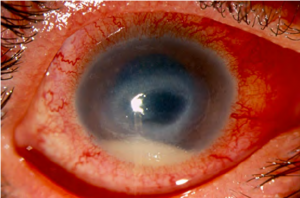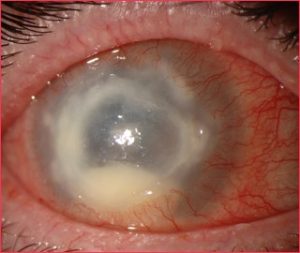CASE REPORT
Case of Acanthamoeba Keratitis a 38-year-old female was admitted to the ophthalmology department in a hospital with pain, redness, watering, and irritation of the left eye. She gave a history of paddy husk injury to the left eye 7 days prior to the development of these symptoms and also noticed a white spot in the left eye 4 days after the injury.

On slit-lamp examination, the left eye showed circumcorneal congestion with a central corneal ulcer of 1.6 x 1.4 mm size with clear margins extending into the superficial stroma. The anterior chamber was normal.
There was no hypopyon. Lacrimal passages were free. Visual acuity in the right eye was 6/6 whereas in the left eye it was 6/18. Multiple corneal ulcer scrapings stained with Giemsa stain showed cysts of Acanthamoeba which was confirmed by culture. No bacteria or fungi were isolated from these corneal ulcer scrapings.
DISEASE of Acanthamoeba Keratitis
Acanthamoeba keratitis, first recognized in 1973, is a rare, vision-threatening, parasitic infection seen most often in contact lens wearers.
It is often characterized by pain out of proportion to findings and the late clinical appearance of a stromal ring-shaped infiltrate. It is both difficult to diagnose and difficult to treat.
MANAGEMENT of Acanthamoeba Keratitis
Medical treatment for Acanthamoeba keratitis is still evolving. Success has been reported with various combinations of antibiotic, antiviral, antifungal, and antiparasitic drugs.
Different regimens include combinations of diamidines, biguanides, antibiotics, and antifungals. Some topical preparations of diamidines are propamidine-isethionate, hexamidine-di isethionate, and dibromopropamidine.

Biguanides include polyhexamethylene biguanide (PHMB), chlorhexidine. Neomycin-polymyxin B-gramicidin is thought to kill bacteria which provides a food source for the acanthamoeba.
Antifungals include topical and oral preparations of voriconazole as well as ketoconazole, miconazole and clotrimazole .
HOW TO TAKE SLIT-LAMP EXAM IMAGES BY A SMARTPHONE?
Smartphone slit-lamp photography is the new advancement in the field of science and technology in which the photographs of the desired slit-lamp finding can be taken with smartphones by using the slit-lamp adaptors.
Read more: Mucormycosis, Plateau Iris, Arcus Senilis, Christmas tree cataract, Crocodile Shagreen
REFERENCES
- Krachmer J, Mannis M, Holland E: CORNEA, 2nd ed.Elsevier Mosby, 2005, 1115-1122.
- Hargrave SL et al: Results of a trial of combined propamidine isethionate and neomycin therapy for Acanthamoeba keratitis. Brolene Study Group, Ophthalmology 106(5):952-957, 1999.
- Bang S, Edell E, Eghrari A, Gottsch J: Treatment with Voriconazole in 3 Eyes with Resistant Acanthamoeba Keratitis. Am Journ Ophthalmol. 2010;149(1):66-69.
- Sun X et al: Acanthamoeba Keratitis: Clinical Characteristics and Management. Ophthalmology 113(3);412-416, 2006.
- Parmar D, Awwad S, Petroll Mm Bowman W, McCulley J, Cavanagh D: Tandem Scanning Confocal Corneal Microscopy in the Diagnosis of Suspected Acanthamoeba Keratitis. Ophthalmology 113(4); 538-547, 2006
- Ocular Pathology Atlas. American Academy of Ophthalmology Web site.

RETINAL IMAGING BY YOUR SMARTPHONE



